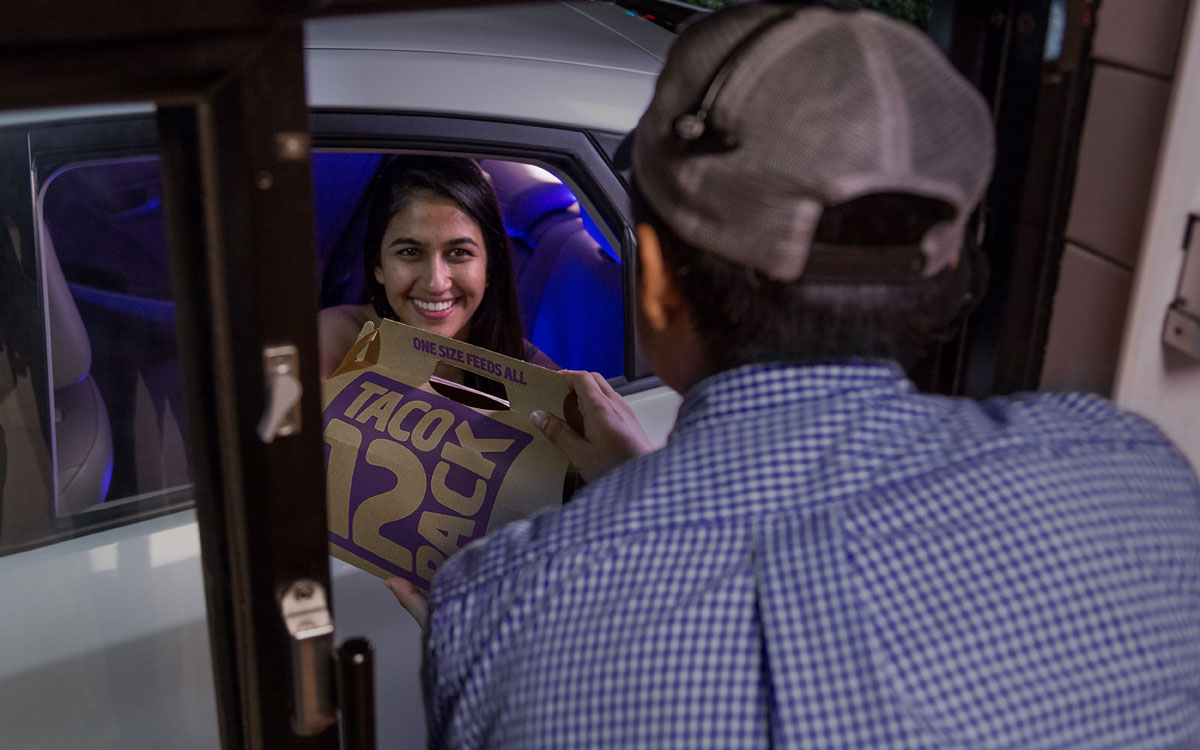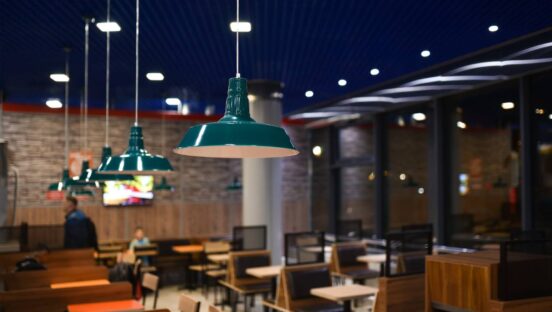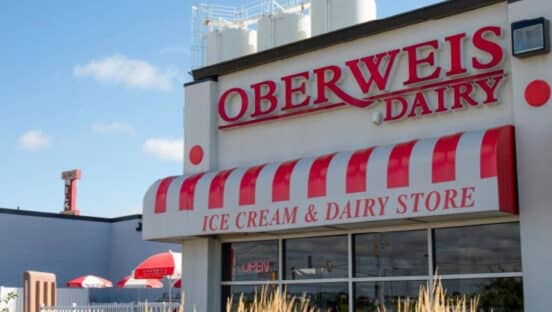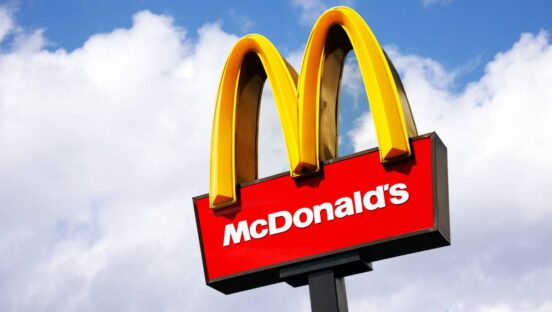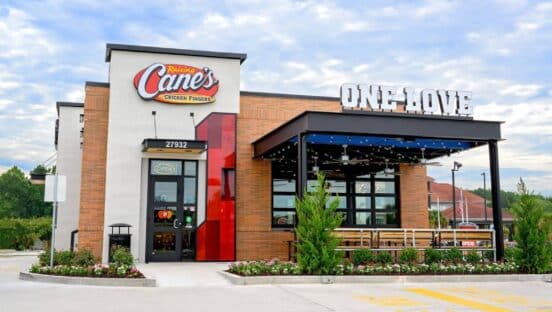We’re all scrambling to materialize the so-called “restaurant of the future.” What COVID-19 trends are fleeting? Which aren’t? Will customers clamor for the same safety essentials months from now? Have protocols and tech dehumanized the experience? Does it even matter?
Picture this environment, outlined by consulting giant Deloitte. A customer strolls into a restaurant with few tables, but two large counters with separate assembly lines behind them. One is labeled “Dine-in/Takeout.” The other, “Delivery Drivers.” The kitchen is busy, but the dining room is quiet. There’s a queue of drivers watching screens for customers’ orders. The restaurant detects a guest when they drive into the parking lot. A notification confirms they’re dining in, and an app shows them to a table. The app then asks if they’d like their usual order. Based on the prediction, the kitchen already began initial preparations the moment they walked in. As the customer exits, they notice one of the drivers with an unusually large bundle. The driver is headed to a “delivery hub,” or a central spot where warmed lockers hold food until people arrive with codes to pick up their meals.
Does this sound outlandish? All of it is taking place in some form today, in one place or another. And it’s what customers are telling restaurants they want—either subtly or directly—through their pandemic behavior. It’s the collision of experience and a new standard for technology and convenience. Or simply, proof the “restaurant of the future” is ahead of schedule.
COVID’s crater into the restaurant space shoved brands into unknown territory within days. Just compare March 6 to March 12. Once dining rooms went dark and guests stopped leaving the house, everything changed. Those were dynamics businesses across the globe were not, understandably, prepared for.
What followed was an outpouring of ad-hoc innovation, Deloitte said. Changes likely to endure, such as mobile tech acceleration and curbside, seized early headlines. But the truth was, a lot of these shifts were the result of forces already in action before the crisis. Some, like digital customer enablement and off-premises preference, will ride a pandemic tailwind well into the future. Others, such as touch-based kiosks and high-capacity dining rooms, could slow or reverse altogether, Deloitte said.
Fast casual Newk’s Eatery, for instance, was racing toward self-order kiosks before COVID. But it suddenly had to ask itself an odd question. Was the “touch” in touchscreen now controversial? “We don’t think anyone wants to go start touching things that somebody else already touched,” president Mike Clock says.
The 120-unit chain abandoned course. It switched gears to “hardware-less kiosks,” or a web app that enabled customers to order and pay using their own devices. Newk’s added mounted placards in restaurants with instructions to scan a QR code. Doing so downloaded a web app where guests could sit or stand wherever they wanted and order and pay. There was no waiting in line with guests. And nothing foreign to touch. Call it tableside ordering with a personal kiosk experience that used the same kiosk software as before, just optimized for a mobile device.
Again, this brings us to the COVID question at hand: Which changes are part of the future, which will be adjusted, and which are evaporating?
Deloitte conducted consumer surveys before and after coronavirus’ emergence to measure existing trends and the impact COVID had on their trajectory. The company then fielded one-on-one interviews with restaurant executives to examine the potential.
It broke down across three key trends:
Ultimate convenience: Consumers demanded this before COVID (drive thus, the rise of third-party delivery).
Frictionless digital experiences: Tech-savvy consumers continue to ask for digital engagement from restaurants and cutting-edge technology that recognizes them and their preferences. Personalization, in every form.
Heightened safety in the wake of COVID: Welcome to the world of remote work models and crowd avoidance.
“Now more than ever, the ball is in each restaurant’s court,” says Jean Chick, principal at Deloitte. “What they do to respond will shape the future of each brand. Restaurants that emerge from this unplanned inflection point in the industry’s history will be set up to provide a new standard in customer convenience, responsiveness, and safety that can pay off long after the tumult of this pandemic is over.”

Convenience counts for more
This is nothing new for quick-serves. But as you’re witnessing with pick-up shelves and the like, customers today want to get their food and get out quicker than ever. They’re not just being lazy or reacting to busy schedules. A lot of guests see walking through the door of a restaurant as a real safety hazard. The faster they can leave and jump into the car, take their mask off, and breathe a sigh of relief, the better.
Delivery (ordering at least once a month, by percentage)
Total population
- Pre COVID: 38 percent
- Post COVID: 52 percent
- Difference: 14 percent
Gen Z
- Pre COVID: 40 percent
- Post COVID: 49 percent
- Difference: 9 percent
Millennials
- Pre COVID: 52 percent
- Post COVID: 65 percent
- Difference: 13 percent
Gen X
- Pre COVID: 49 percent
- Post COVID: 51 percent
- Difference: 12 percent
Boomers
- Pre COVID: 24 percent
- Post COVID: 40 percent
- Difference: 18 percent
Silent
- Pre COVID: 8 percent
- Post COVID: 34 percent
- Difference: 26 percent
Takeout
Total population
- Pre COVID: 45 percent
- Post COVID: 68 percent
- Difference: 14 percent
Gen Z
- Pre COVID: 51 percent
- Post COVID: 62 percent
- Difference: 11 percent
Millennials
- Pre COVID: 66 percent
- Post COVID: 76 percent
- Difference: 10 percent
Gen X
- Pre COVID: 57 percent
- Post COVID: 77 percent
- Difference: 20 percent
Boomers
- Pre COVID: 49 percent
- Post COVID: 65 percent
- Difference: 16 percent
Silent
- Pre COVID: 38 percent
- Post COVID: 51 percent
- Difference: 13 percent
While some of this is driven by necessity (fewer dining rooms open), the takeout adoption is remarkably high.
Even in places with open dining rooms, personal safety is playing into the decision-making process—which is a COVID-specific outlier. Per Deloitte, a lot of consumers don’t see spiking delivery and takeout behavior slipping away completely when this is over. Sixty-two percent cited “convenience” as the reason they’re patronizing restaurants today. What makes a convenient experience? Delivery costs, wait times, and pickup location. And now, contact, Deloitte said. Or a lack thereof.
You have to consider, convenience is not always defined by speed. There are multiple factors at work. It’s like buying a car. Getting in and out is great, but so is the price, customer service, and how seamless (or agonizing) the experience was.
Consumers want a convenient experience, Deloitte said, where they can get food on their own terms. They are willing to pay for it. On average, Deloitte found diners consider a $4 delivery fee fair. Wait time was important, yet people were flexible. Still, customers across all generations leaned toward quicker options.
A reasonable wait time?
- Up to 30 minutes: 75 percent
- Up to 45 minutes: 20 percent
- Up to 60 minutes: 5 percent
Going back to Deloitte’s image of a driver taking meals to a delivery hub, nearly two-thirds of customers said they were willing to pick up from a convenient location other than the restaurant itself. Imagine shelves arranged by restaurant and patron name, one friendly attendant, or even your own personal locker (like Amazon does)—along with reduced or eliminated delivery fees for guests who use the hub.
This is a rather interesting notion. Perhaps the evolution of the ghost kitchen craze for pickup-centric operations?
In addition, 44 percent of Deloitte’s respondents said they’d order delivery of uncooked meals they finish prepping at home. Take-home kits, in other terms. “For some consumers, the restaurant of the future may not look like a restaurant at all,” Deloitte said.
For operators, Deloitte cautioned brands that apply innovation and investment energy too broadly could end up with scattershot adjustments that don’t drive to the core of this new reality.
Zero in on specifics. Countless restaurants are finding that dining out no longer means dining in. Once more, this is a multi-year trend line. The massive shift in 2020, however, with takeout, delivery and drive thru, is almost certainly going to stick long term. It’s why chains like McDonald’s, Taco Bell, Shake Shack, Wendy’s, Burger King, Chipotle, and others are building prototypes with smaller dining rooms, or no dining rooms, and direct focus on drive thru, app ordering, and curbside. Two “national fast-food brands” told Deloitte they’re experimenting with stores 40 or 50 percent smaller than before, with less space for dining and more capacity for off-premises business.
They’re also exploring updated location designs that allow employees to bring food from the kitchen straight to customers or delivery drivers. Burger King is even plotting a conveyor belt system.
Meanwhile, salad bars and buffets have all but disappeared, Deloitte said. Indeed, Garden Fresh went Chapter 7, while Golden Corral’s largest franchisee declared bankruptcy.
And as things transform inside restaurants, they’re changing outside, too. This is occurring with added drive-thru lanes and brands jostling for convenience share. Noodles & Company and Chipotle recently said the vast majority of their future growth will feature pick-up windows. In these cases, without menuboards and the traditional ordering process. Both will flow exclusively through digital ordering.
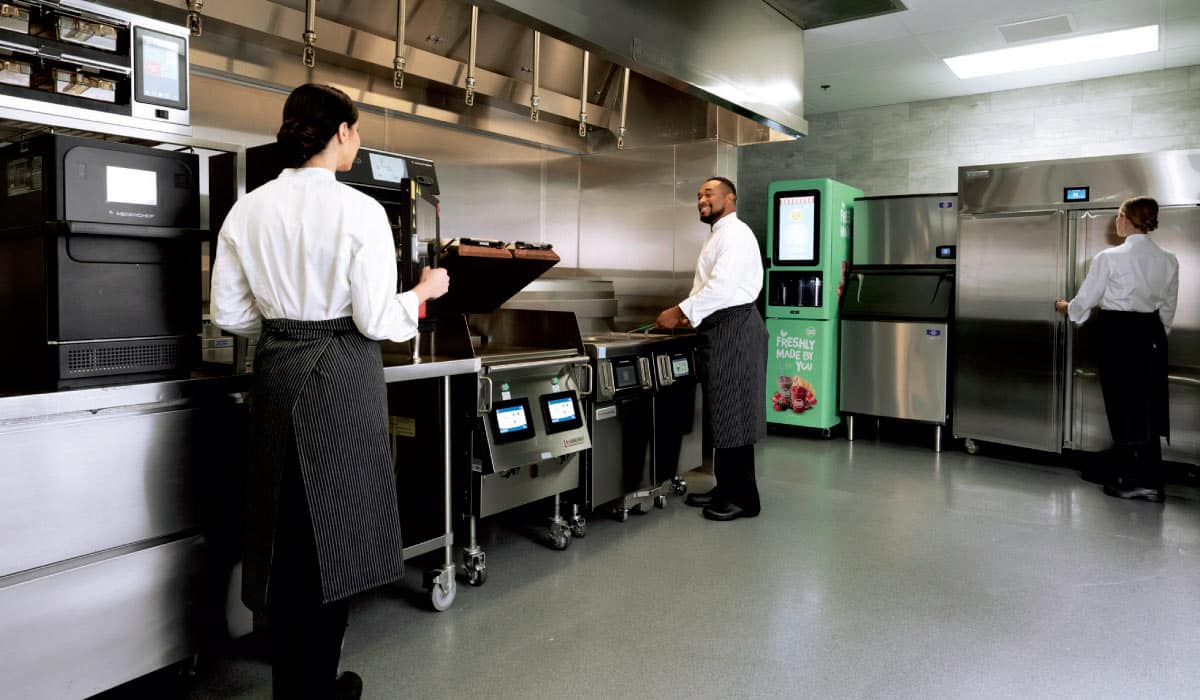
Certain drive-thru legacy players, like Starbucks, are investing in things like order takers and tablets to roam the line and boost throughput.
“Some stores are experimenting with express lanes that allow the ‘just want a coffee’ customer to finish and go while the minivan driver is still sorting out seven different value meal orders. One brand has established a location that is nothing but drive-through—five lanes, like a bank,” Deloitte said.
Another anecdote was a restaurant using computer vision to recognize a car or license plate, eliminating the need for ordering or payment interactions. Voice recognition, as McDonald’s continues to test, is coming as well.
In regards to staffing this surge, some quick-serves added parallel order preparation lines in stores to dedicate employees to off-premises needs (like Chipotle and its $1 million per unit second make-lines). Sometimes this comes at the expense of unused dining room space. It can be a way to rethink current stores instead of rebuilding new ones.
Packaging updates, delivery-only menus to omit foods that don’t travel well, and digital advances such as algorithms that precisely time cooking, are unlocks for restaurants, too, Deloitte said. For example, a pizza can be triggered to come out of the oven based on when the delivery driver is ready to pick it up, not when it was ordered.
James Walker, SVP of Nathan’s Famous, says his brand put the practice into action once off-premises surged and it realized there was a driver shortage. It adjusted fire times to wait just a couple minutes before arrival to start preparing orders. Better the driver wait a minute than the customer wait 45.
“The brand has to own the overall experience. So regardless of whom my delivery service provider is, I have to do everything within my power to deliver a great experience,” Walker says. “… While the overall delivery cycle time maybe unavoidable, just due to lack of drivers and increase in demand, I want to, certainly, deliver hot food to that guest. So I take it upon myself to adjust the fire times to make sure that that food that goes out, even if it should be 10 minutes and turns out to be 45, at the 45 minute mark it should go out hot and fresh.”
“The tools the restaurant industry has relied on for generations—quality, service, and in-person experience—can carry them only so far in answering this rising demand for convenience,” Deloitte adds. “To win the battle for differentiation and market share, the new frontier is digital.”
Remove the friction, remove the doubt
It wasn’t that long ago customers could take a stance on tech adoption. They loved it or they didn’t. They can hate it now, but they still have to embrace it.
- Prefer to order digital for off-premises delivery: 70 percent
- Prefer to order digitally from a quick-service restaurant: 58 percent
- Have a third-party delivery app on their phones: 57 percent
- Follow a social media account from a restaurant or food brand: 48 percent
- Would consider driverless or drone delivery: 40 percent
- Have chosen a restaurant based on a social media post or photo: 21 percent
This might sound crazy, but before COVID, Deloitte’s data showed, restaurant customers across all segments preferred dealing with cashiers to using apps. Today, it’s reversed. Options like voice assistants and wearables are also gaining momentum. Whatever a guest’s preferred method of ordering, consumers said they would pay an average of 14 percent more for the chance to use it—and since 70 percent prefer digital interactions, digital equals dollars, Deloitte said.
Customers who say technology options make it more likely they’ll …
- Dine in: 26 percent
- Order delivery: 30 percent
The roadmap to restaurants gathering app signups, Deloitte said, is to one, focus on ease of use. Two, look to expected frequency of use. And lastly, invest in personalized offers and promotions.
“Meet those needs and you may be more likely to win a place on their phones. But note that people delete restaurant apps they don’t use—so keeping users engaged will require giving them what they want,” Deloitte said.
Knowing and understanding this customer isn’t easy. It breaks too many past molds. But the good news is there’s share to gain and innovation to introduce with something so unexplored.
From Deloitte’s survey, here’s a look at some consumer attitudes about fresh approaches.
Ordering
When customers choose how to get their food, their top priorities are convenience (58 percent) and speed (49 percent). Any alternative ordering method should honor this twin mandate, Deloitte said. So a smart home device, text, or even a virtual reality app might seem cutting edge, but the minutes that pass while patrons await their food are the same minutes they counted when they used to order from the Yellow Pages. In other terms, the core tenets of running a restaurant still apply to running the restaurant of the future. Tech can’t cover for a poorly run restaurant.
Kitchen location
Deloitte brings up ghost kitchens. Basically, when it comes to takeout and delivery, do customers care where the food is actually located? More than half (56 percent) of respondents said they’d be willing to order from a restaurant with no customer-facing front of house. If there are more locations preparing food, it opens the possibility of shortening delivery distances and times. And in this particular dynamic, those factors are more important. This puts added emphasis on packaging and data collection. Brand value is always worth guarding.
Service areas
A smaller or more precisely defined delivery area can make using driverless cars or even drones more feasible, Deloitte said. It would also reduce costs and delivery times. Close to half (48 percent) of consumers said they’d be fine with one of those options.
Centralized go-to areas
Sometimes you go to a restaurant. Sometimes it comes to you. Deloitte suggested a “handoff in the middle.” Customers are familiar with retail locker delivery in many places, and 65 percent said they’d be willing to pick up food that way if the spot was less than a 10-minute walk or drive away, or if the location was along their commute. A digital app could help identify those convenient locations based on people’s driving routes and make the connection. Think of it like those charging station finders, but for food.
Deloitte brings up the question, are restaurants behind in delivering a next-generation digital experiences? Before COVID, the answer probably was yes. But the sector is catching up faster than most.
“Some digital offerings are just about de rigueur,” Deloitte said. “A user-friendly, frictionless digital platform that brings useful interaction—including payments—to web and mobile environments is the bare minimum required to capture customers and the market share they represent.”

Gone is the novelty factor with apps. Apps can’t just exist; they need to stand out from the field. For the customer, Deloitte said, it must permit “order anywhere” functionality, not just ordering at the point of sale. For the restaurant, the app and its functions need to integration with the existing CRM. Payment registration with a restaurant should make it possible for a guest to pay within the branded app no matter how the food is delivered or where it’s eaten.
Deloitte put it this way: “On a future-ready platform, the context of a digital experience will depend on the ways a customer interacts with the brand, not by the channel the interaction flows through.’
A customer wants consistent, pervasive digital experiences across every touchpoint. Delivery, drive thru, apps, and websites should all feel alike, Deloitte said. And digital interactions should be tailored to what users might want to see at each moment.
For instance, if somebody selected a “delivery” tab on a menu on an app, the app could automatically display the current predicted delivery time at the top of the screen. If they pick “curbside,” it might offer open curbside spots to park in. Inside restaurants, it could tell them where to sit and wait for their food. Customized, consistent digital experiences that strengthen engagement and lead to confidence in the brand.
It all has to be connected, otherwise the burden could outweigh the benefit. Among the key reasons it’s important for digital POS technology to connect with a restaurant’s back-end functions, is to fuel customer analytics, inform loyalty program enhancements, and to come back to customers with an experience that’s truly personalized. It’s the next step after shedding “tablet hell” to prevent bottlenecks in the back. Now, we’re talking the evolution of serving digital orders to actually improve guest connections.
“If all that happens is an order, a payment, and a delivery, the restaurant loses an opportunity to make each interaction additive to a long-term customer relationship,” Deloitte said.
As customers interact with restaurants in new, digital ways, it’s more important for the restaurant’s systems to maintain a single, informed view of each customer no matter which ordering method they use next, the company added.
Data is currency. With the right outlook, restaurants can steal one of digital retail’s signature methods—the “you might also like” menu offering. McDonald’s, for one, uses its Dynamic Yield technology to adjust suggestions based on things like past behavior, the weather, and what’s trending.
Personal data and analytics are allowing for more “smart upsells” at the time of transaction. “When a brand understands the guest and his or her trends, frequencies, and patterns, it doesn’t just open the door to more sales,” Deloitte said. “It allows a deeper integration into the customer’s life. That’s the beginning of a relationship.”
Additionally, well-informed loyalty programs are gaining speed. They can be profitable if they have the information to offer mutually beneficial deals, not just to give things away for free. Restaurants increasingly are moving rewards platforms away from direct transaction models to improve efficacy. Deloitte suggested operators keep email on tap even as these new models emerge. Timely, personalized communications via a customer’s preferred channel could unlock frequency in an era where loyalty is stronger than it was pre-virus. As the adage goes, it’s always cheaper to retain a guest than to acquire a new one. And it’s probably worth giving away an appetizer for.
Are kiosks going to be among the losers of COVID’s realignment? There’s no question they face a bumpier road today. Less in-store dining is naturally a deterrent. So is what Newk’s Clock mentioned earlier—the idea of multiple people touching the same screen. And if the solution is to constantly clean between use, how will that affect throughput? Labor?
Deloitte said it’s more likely customers will see connected tablets in the hands of “augmented” attendants or at drive thru and curbside points of sale.
It added restaurants are questioning the future of previously essential POS systems “in a world where the sale can happen anywhere.”
An answer for some has been to integrate the POS and digital assets onto a single technology platform that consolidates ordering, operations, and customer data. Others, Deloitte said, are redefining business processes to welcome new points of sale. And some are even exploring getting rid of legacy POS systems to focus instead on cloud-based solutions, or even extending ecommerce functionality to the physical restaurant to process orders.
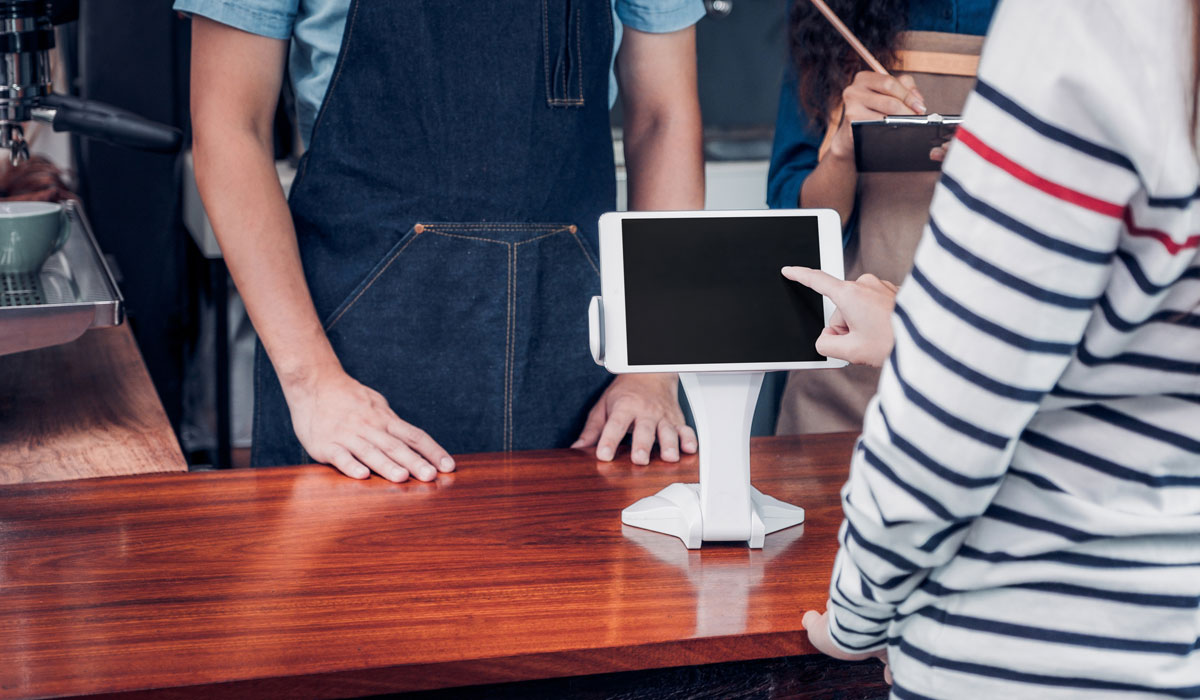
Digital payment is getting easier for restaurants. Touchless options via near-field communication (NFC) on mobile phones is moving from innovative to table stakes, Deloitte said.
Restaurant owners told the company high-level options like robotic and drone delivery aren’t an immediate focus. Instead, AI-driven natural language processing that can let machines handle text and voice orders, or integration with in-car or in-home digital assistants, like Alexa, for ordering on the go appears more imminent.
Sensing technologies, such as WiFi, GPS, Bluetooth beacons, and NFC, are all potential pathways for a personalized customer experience, Deloitte said.
“For example, geofencing can match certain offerings to certain physical locations. Sensing paired with blockchain can enhance supply chain visibility. That can help deliver peace of mind when people know their ingredients are safely sourced and handled,” the company said.
Digital tech in the back of the house can’t be overlooked, either. One example is demand management and automated forecasting that could drive robotic sequences so every morning finds the right amount of pancake and omelet fixings ready to use. Or imagine a fryer heating up in anticipation of a spike in French fry orders. Driver routing mechanisms could take traffic and weather into account in real-time, allowing a driver to make more deliveries, quicker, Deloitte said.
Important to this future outlook is to understand what works and what doesn’t, where to automate and where to keep the human element involved. As an executive told Deloitte, “Nobody has ever said, ‘I love the way you guys unload a truck.’”
But the idea of automating pizza might not work for everybody. It depends on the restaurant, of course, and the customer, and where it gets credit and where it doesn’t. Don’t take labor out of the restaurant just because you can. Losing brand equity costs more in the long term than saving on hours.
Safety and trends
Deloitte’s Center for Consumer Insights discovered that, as of late July, restaurant spending was down more than 20 percent compared to year-ago levels. The gap, though, was starting to narrow. Meanwhile, average checks were climbing form June to July (this is mostly a quick-service reality. Full-serves feel the loss from beverages with off-premises orders).
For quick-service brands, family meals and the lack of solo occasions drove the lift.
One of the earliest social effects was an increase in at-home cooking. Half of Deloitte’s respondents said they won’t go back to normal for at least six months. However, when their cooking versus ordering patters return to prior norms, almost a quarter (23 percent) said their new, more frequent takeout and delivery habits would be permanent. “This means the arena where restaurants need to win, right now, is off-premises dining,” Deloitte said.
A top formula, the company added, isn’t just providing safety, but making safety consistently visible. This, too, is something nobody would have expected before coronavirus.
Four out of five people said they’d be more likely to visit a restaurant if they knew what steps it took to enhance cleanliness, food safety, or guest safety, and when they did, they would be willing to pay an average of 10 percent more. It’s clear then why communication and transparency deserves a premium. Frequent diners said they were more likely (56 percent) to trust brand websites than the general clientele (43 percent).
What about the long-term? Half of people who stopped going to a restaurant said it’s not because of delivery options or safety practices, but rather because the location closed due to COVID. Half said they would visit a restaurant that returns to pre-crisis norms even without visible changes.
“The thread of hope brands can take from this is that as locations reopen, customers will have a desire to return,” Deloitte said.
What do consumers want from restaurants in the wake of COVID?
- Surfaces cleaned after each use: 87 percent
- Personal control of cleaning: 85 percent
- Visible cleaning practices: 85 percent
- Official certification of cleanliness: 84 percent
- Measures to ensure employee health and safety: 82 percent
A lot of restaurants are paring down menus to improve execution and allow stores to focus more on safety protocols. To also helps with supply chain interruptions. Other menu changes meet those check demands, like family bundles. “Like changes to the physical layout, menu changes are likely here to stay,” Deloitte said.
“Restaurants that emerge from this unplanned inflection point in the industry’s history will be set up to provide a new standard in customer convenience, responsiveness, and safety that will pay off long after the tumult of this pandemic is over,” the company added.

